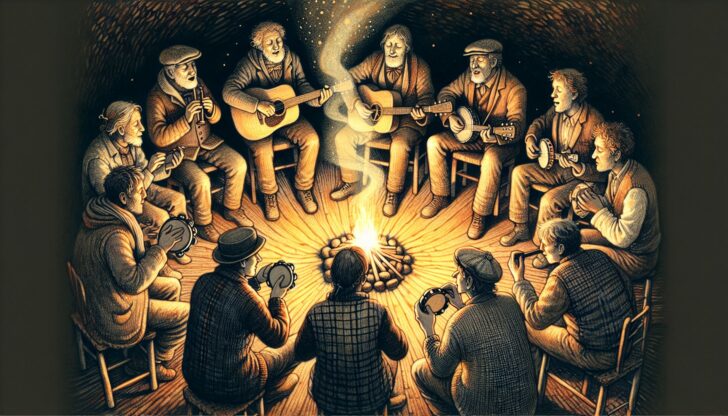What makes folk melodies so captivating and universally enduring? This guide ranks the top 50 folk tunes that have not only defined the genre but continue to inspire listeners around the globe. Delve into the origins, stories, and cultural significance of each melody without any fluff—just pure musical intrigue to understand why these songs remain timeless.
Table of Contents
Key Takeaways
Folk music’s simplicity makes it universally accessible, capturing life’s core themes and emotions, and allowing easy sharing through memorable structures like the AABB form.
Folk melodies chronicle cultural identities and histories, reflecting a diverse range of influences from Appalachian and Celtic to global traditions, all of which contribute to its rich, evolving tapestry.
Modern folk continues to thrive, blending with various genres and harnessing digital platforms, while still serving as a potent expression of societal values, heritage, and protest across communities.
The Essence of Folk Melodies

The allure of folk songs lies in their remarkable simplicity and profound accessibility. With straightforward structures that echo the rhythms of daily life, these melodies are designed to be easily learned, sung, and passed along. Whether it’s the hum of a lullaby or the vigor of a work chant, folk music captures the universal themes of human experience—love, work, conflict, and celebration—while offering a deep emotional connection born from shared narratives.
It’s no wonder that folk songs have been embraced across continents, as their narrative style and strophic forms resonate with the common threads of our existence.
The Structure of a Folk Tune
Take, for instance, the humble folk tune. Often a short instrumental piece, its repeating sections—like the familiar AABB form—serve as the backbone for storytelling and oral transmission. These patterns are not only pleasing to the ear but practical; they aid in memorization, allowing tunes to be recalled and shared effortlessly across generations.
The structure of a folk tune is akin to the architecture of a well-told tale, providing a predictable and robust framework for the lyrics and melodies to dance upon.
Themes and Narratives in Melody
Beyond their structural allure, folk songs are vessels carrying the weight of intricate social concepts and local concerns. They reflect cultural impacts and collective consciousness, encapsulating the essence of an era or community within their melodies. A single folk song can traverse the spectrum of emotion and experience, uniting people under the banner of shared history and values. From the haunting refrains of “Waltzing Matilda” to the earnest pleas of “All the Flowers,” these songs continue to resonate with listeners worldwide.
Repetition and Variation
The magic of folk music also lies in its use of repetition and variation. Repetition acts as a mnemonic device, embedding the tunes in memory and facilitating their journey from one singer to another. And yet, within this repetition, there is room for variation. As each folk singer breathes new life into a traditional song, they impart their personal stamp, ensuring that the music remains fresh and relevant.
This balance between the familiar and the new allows for the preservation of cultural nuances and community identity, as the songs evolve organically through the natural selection of competing variants.
The Birthplace of Folk: Tracing Regional Roots
As we delve into the heartlands of folk music, we uncover a rich mosaic of regional styles, each shaped by a complex history of migrations and cultural exchanges. From the Appalachian Mountains to the rugged coastlines of Newfoundland, folk music serves as both a reflection and a celebration of cultural heritage. Acoustic instruments like guitars, banjos, and fiddles are the storytellers of this genre, hinting at folk’s communal roots in storytelling and dance.
It’s a genre that knows no borders, embracing the diverse sounds of Balkan brass bands and the intricate rhythms that reflect a storied past under the Ottoman Empire.
Appalachian Echoes: The Sound of American Folk
In the rolling hills of Appalachia, a distinctive sound emerged, one that married the musical traditions of Irish, Scottish, and English settlers with African influences. Instruments like the American fiddle and banjo became the voices of a new American narrative, while techniques such as lining out and yodeling enriched the region’s musical tapestry. The “High Lonesome Sound,” characterized by its piercing vocal timbre and pentatonic scales, became synonymous with Appalachian music, echoing through tunes like “Leather Britches” and “Cumberland Gap”.
It’s a sound that’s undeniably folk, where every string pluck and vocal wail tells the story of a people and their land.
Celtic Tunes and Their Lasting Legacy
Celtic tunes have woven their threads deep into the fabric of folk music, their influence echoing in the valleys of Appalachia and beyond. The ballads and hymns of the British Isles have left an indelible mark, shaping regional sounds and preserving cultural heritage.
Songs like “The Band Played Waltzing Matilda” and “The Circle Game” are testaments to the enduring legacy of Celtic melodies, illustrating how they continue to inspire and inform the genre.
Global Folk: A Tapestry of International Sounds
But the story of folk music doesn’t end at the shores of the Atlantic. Across the globe, from the intricate social commentaries in Korean folk to the classical orchestras of Sri Lanka, folk music reflects the unique characteristics and histories of regions the world over. In India, ancient folk songs like Khunung Eshei/Khuland Eshei carry the cultural essence of their people, while in Nigeria, folk melodies serve as an informal code of conduct, weaving societal norms into their storytelling.
The diversity of global folk music is a testament to its power as a universal language, uniting us in song across continents and cultures.
Icons of Folk Music and Their Timeless Tunes

As we traverse the storied landscape of folk, we encounter icons whose timeless tunes have become anthems of generations. The American folk music revival introduced us to legends like Woody Guthrie, Pete Seeger, and Bob Dylan, who not only sang traditional songs but also composed originals that have become essential folk songs. These troubadours of change, including figures like Phil Ochs and Joan Baez, used their music to shape and reflect the zeitgeist, leaving an indelible mark on the genre.
Troubadours of Change: Bob Dylan and Joan Baez
Bob Dylan, initially revered as a folk singer, revolutionized the genre by weaving rock and roll elements into his music, offering a new paradigm of songwriting and performance. His introspective lyrics and the birth of folk rock forever altered the musical landscape.
Meanwhile, Joan Baez’s crystalline voice and her renditions of traditional ballads played a pivotal role in popularizing historic folk melodies and bringing Dylan to the limelight years ago. Together, they underscored the power of folk music as a vehicle for political and social change during the tumultuous 1960s.
The Canadian Narrative: Stan Rogers and Joni Mitchell
The Canadian narrative in folk music is richly depicted through the powerful storytelling of artists like Stan Rogers, Joni Mitchell, Dave Carter, Eric Andersen, John Prine, Paul Simon, and Steve Goodman. Rogers’s “Mary Ellen Carter” and Mitchell’s “Big Yellow Taxi” stand as cultural landmarks, reflecting the heart and soul of Canadian history and the environment.
Though Rogers’s life was tragically cut short, his legacy endures, with his music continuing to resonate and inspire long after his passing.
The British Influence: Shirley Collins and Martin Carthy
Crossing the pond, the British folk scene’s influence is unmistakable, with artists like Shirley Collins, Richard Watson, and Martin Carthy weaving the threads of English history into their music. Their renditions of “Poor Murdered Woman” not only tell a haunting true story but also preserve a piece of 19th-century life for modern audiences.
England’s periodic folk revivals and its seminal influence on American and Canadian folk underscore the genre’s international reach and enduring appeal.
Modern Folk: Evolution and Crossover
Folk music’s journey continues as it evolves and diversifies, embracing new sounds and fusion genres that blend traditional elements with modern influences. The mid to late 20th century witnessed the birth of folk rock, while the indie folk renaissance brought a fresh DIY approach to the genre.
Bands like Mumford & Sons and Fleet Foxes have become standard-bearers of this modern folk movement, introducing traditional melodies to a new generation of listeners.
Folk Fusion: Blending with Country, Rock, and Beyond
The fusion of folk with country music, rock, and even psychedelia has expanded the genre’s horizons, creating a melting pot of sounds that defy traditional categorization. This blending has given rise to sub-genres like country folk, where the storytelling prowess of folk converges with the twang of country to form a rich, hybrid style.
Check out Classical Crossover Music’s Timeless Fusion
The Indie Folk Renaissance
The indie folk renaissance, ignited in the early 2000s, signaled a resurgence of interest in folk music within the indie community. Artists like Mumford & Sons and Fleet Foxes gained acclaim by infusing traditional folk sounds with indie rock sensibilities, propelling the genre to new heights of popularity and commercial success.
Folk Music in the Digital Age
The digital age has reshaped the presentation and accessibility of folk music, with technology and online platforms amplifying its reach. The DIY ethos of modern folk artists, coupled with the ability to self-release music on platforms like Bandcamp, has enabled a new wave of folk musicians to connect with audiences worldwide, echoing the communal roots of the genre in a contemporary setting.
The Cultural Significance of Folk Songs
Folk music’s resonance extends beyond melodies and rhythms; it is a cultural touchstone that embodies the shared experiences and traditions of communities around the world. Its simplicity allows for wide participation, making it a potent tool for preserving cultural identities and expressing the shared emotional experiences of love, hardship, and celebration.
In regions where music serves as a national or cultural badge, the preservation of folk traditions becomes a powerful testament to a people’s history and values.
Folk as a Reflection of Societal Values
Folk music serves as a reflection of a community’s values, history, and collective struggles, contributing to a sense of cultural identity. Created casually by cultures often without commercial intent, folk music showcases a pure expression of societal values, echoing the collective experience of workers, their labor, and the rhythms of their daily lives.
Preserving Heritage Through Melody
As a vessel for cultural heritage, traditional folk music educates younger generations about their roots and the stories of their ancestors. Efforts to preserve these melodies, such as the work of the American Folklore Society and collectors like Francis James Child and Cecil Sharp, have been instrumental in maintaining the legacy of folk traditions for future generations.
The Power of Protest and Solidarity
Throughout history, folk melodies have played an integral role in political movements, serving as anthems that unite and mobilize communities. Songs like “We Shall Overcome,” performed at the 1963 March on Washington, exemplify the powerful role folk music can play in societal change, illustrating its ability to bring people together in protest and solidarity.
Summary
From the simple strains of a mountain ballad to the stirring anthems of political change, folk music has etched its melodies into the fabric of our collective consciousness. It has evolved from the communal firesides of old to the digital streams of the modern age, yet its core remains unchanged: to tell the stories of a people, to preserve their heritage, and to unite them in song. As we’ve journeyed through the history, evolution, and cultural significance of folk music, it’s clear that this genre is not just a relic of the past but an ever-evolving conversation between generations. May the songs continue to resonate, reminding us of where we’ve been and inspiring us to where we’re going.
Frequently Asked Questions
What defines the structure of a folk tune?
The structure of a folk tune is typically defined by repeating sections like the AABB form, which help with memorization and storytelling, creating a predictable framework for oral transmission.
How did Bob Dylan transform the genre of folk music?
Bob Dylan transformed folk music by blending it with rock and roll elements, personal introspection, and electric instruments, which gave rise to the genre of folk rock.
What is the indie folk renaissance?
The indie folk renaissance started in the early 2000s as indie artists began infusing traditional folk elements into their music, sparking a renewed interest in the genre and its development. It’s all about blending traditional folk with a modern indie twist.
How has digital technology affected folk music?
Digital technology has made folk music more accessible, allowing artists to independently record and distribute their music, expanding the genre’s reach. This has also encouraged the use of lo-fi techniques and DIY approaches, bringing a fresh perspective to folk music.
Why is folk music important for cultural preservation?
Folk music is important for cultural preservation because it passes down traditions, stories, and values through generations, maintaining cultural identity and heritage. It serves as a vessel for preserving cultural traditions.









